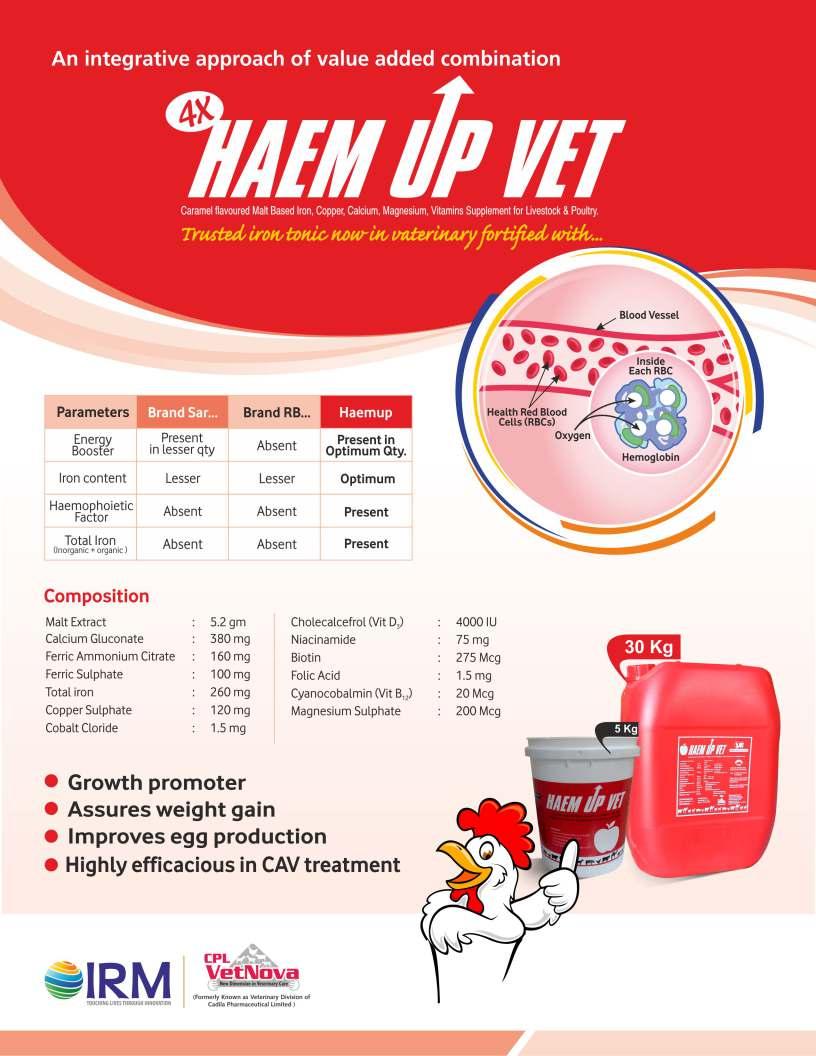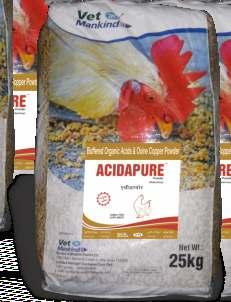
6 minute read
Iron Absorption & Role - An Overview
Dr. Yogesh Paharia
B.V.Sc , M.V.Sc ( Nutrition )
Advertisement
Iron is an essential element of various metabolic processes in animals including DNA synthesis, electron transport, and oxygen transport. Unlike other minerals, iron levels in the body are controlled only by absorption. The mechanism of iron excretion is an unregulated process arrived at through loss in sweat, menstruation, shedding of hair and skin cells, and through rapid turnover and excretion of enterocytes. In the animal's body, iron exists mainly in erythrocytes as the heme compound haemoglobin, to a lesser extent in storage compounds (ferritin and hemosiderin) and in muscle cells as myoglobin. Iron also is found bound to proteins (hemoprotein) and in non-heme enzymes involved in oxidation-reduction reactions and the transfer of electrons (cytochromes and catalase).
There are two types of absorbable dietary iron: heme and non-heme iron.
Heme iron, derived from haemoglobin and myoglobin of animal food sources (meat, seafood, and poultry), is the most easily absorbable form (15% to 35%) and contributes 10% or more of our total absorbed iron.
Non-heme iron is derived from plants and iron-fortified foods and is less-well absorbed. Despite its relative abundance in the environment and the relatively low daily iron requirements, iron is often a growth-limiting nutrient in the animal's diet. One reason for the lack of adequate iron absorption is that upon exposure to oxygen, iron forms highly insoluble oxides which are unavailable for absorption in the gastrointestinal tract. Enterocytes contain apical membrane-bound enzymes whose activity can be regulated and which function to reduce insoluble ferric (Fe3+) to absorbable ferrous (Fe2+) ions. Iron absorption is a rapid process. Following the administration of a radioactive dose of iron into the lumen of the proximal small intestine, radioactivity usually appears in the circulation within 15 s, and within minutes, 60%–80% of the total amount ultimately absorbed is transferred into the body. This initial phase of rapid iron uptake is followed by a slower rate of transfer that continues for 12–48 h. It is likely that this iron was initially retained within enterocytes in ferritin. Some iron stored in ferritin, however, never makes it into the circulation since it is lost when mucosal cells are exfoliated at the end of their lifespans. 83 During iron deficiency, not only is the total amount of iron absorbed greater but also the fraction retained within the enterocyte is much smaller. Although iron deficiency is a relatively common problem, it is not the only extreme of the iron-balance spectrum that must be avoided. Iron overload can be particularly damaging to the heart, liver, and endocrine organs. Excess ferrous iron forms free hydroxyl radicals via the Fenton reaction that cause damage to tissues through oxidative reactions with lipids, proteins, and nucleic acids. Thus, dietary iron absorption and factors affecting bio availability in the body are tightly regulated where possible.
Cellular
The absorption of most dietary iron occurs in the duodenum and proximal jejunum and depends heavily on the physical state of the iron atom. At physiological pH, iron exists in the oxidized, ferric (Fe3+) state. To be absorbed, iron must be in the ferrous (Fe2+) state or bound by a protein such as heme. The low pH of gastric acid in the proximal duodenum allows a ferric reductase enzyme, duodenal cytochrome B (Dcytb), on the brush border of the enterocytes to convert the insoluble ferric (Fe3+) to absorbable ferrous (Fe2+) ions. The gastric acid production plays a key role in plasma iron homeostasis. When protonpump inhibiting drugs such as omeprazole are used, iron absorption is greatly reduced. The duodenal pH-dependent process of iron absorption is inhibited or enhanced by certain dietary compounds.
Ÿ Inhibitors of iron absorption include Phyate which is a compound found in plant-based diets that demonstrate a dosedependent effect on iron absorption. Polyphenols are found in black and herbal tea,

coffee, wine, legumes, cereals, fruit, and vegetables and have been demonstrated to inhibit iron absorption. Unlike other inhibitors such as polyphenols and phytates which prevent only non-heme iron absorption,
Calcium inhibits both heme and non-heme iron at the point of initial uptake into enterocytes.
Animal proteins such as casein, whey, egg whites, and proteins from plants (soy protein) have been shown to inhibit iron absorption. Oxalic acid is found in spinach, chard, beans, and nuts and acts to bind and inhibit iron absorption.
Enhancers of iron absorption are dominated by the effect of ascorbic acid (vitamin C) which can overcome the effects of all dietary inhibitors when it is included in a diet with high nonheme iron availability (usually a meal heavy in vegetables).
Ascorbic acid forms a chelate with ferric (Fe3+) iron in the low pH of the stomach which persists and remains soluble in the alkaline environment of the duodenum.
Molecular
Once inside the enterocyte, iron can be stored as ferritin or transported through the basolateral membrane and into circulation bound to ferroportin. Monomers of the ferritin molecule have ferroxidase activity (Fe3+ ↔ Fe2+) which allows the mobilization of Fe2+ ions out of the ferrihydrite mineral lattice structure, enabling its subsequent efflux out of the enterocyte via ferroportin, and into circulation across the basolateral membrane ofthe enterocyte Iron movement across the enterocyte is usually considered in terms of three phases or steps iron uptake—the movement of iron from the intestinal lumen across the BBM and into the enterocyte; (2) an intracellular phase where iron is stored or utilized within the enterocyte or directed to the BLM for subsequent export; and (3) the export of iron across the BLM and into the interstitial fluids which bathe the serosal side of enterocytes, the so-called transfer step. The small intestine is able to utilize different forms of iron and it is the BBM proteins that must deal with this variety. The utilization of inorganic, or nonheme, iron (which is likely bound to low molecular weight organic acids) is particularly important and has been most extensively studied If hepcidin levels are low and ferroportin is not down regulated, ferrous (Fe2+) iron can be released from the enterocyte, where it is oxidized once again into ferric (Fe3+) iron for binding to transferrin, it's carrier protein which is present in the plasma. Two copper-containing enzymes, ceruloplasmin in the plasma and hephaestin on the basolateral membrane of the enterocyte catalyze the oxidation of and subsequent binding of ferrous iron to transferrin in the plasma. The principal role of transferrin is to chelate iron so that it can be rendered soluble, prevent the formation of reactive oxygen species, and facilitate its transport into cells. Conditions that degrade the mucosa of the duodenum will decrease absorption of iron Anaemia of chronic disease is a normochromic, normocytic anaemia which shows characteristically elevated ferritin stores but lower total body iron. Disease states increase cytokine release (IL-6) which stimulates hepcidin expression in the liver. Hepcidin causes decreased iron absorption through ferroportin degradation and decreases the release of iron from macrophages. The iron that accumulates in cells in anaemia of chronic disease is stored as ferritin. Iron-deficiency anaemia is a hypochromic, microcytic anaemia caused by hemorrhage (most commonly through trauma or gastrointestinal lesions), decreased dietary iron, or decreased iron absorption. Female of reproductive age require twice the amount of iron as similarly-aged animals. Pregnancy and calves feeding also significantly increase the iron requirements of animals, helping to make iron deficiency the most common dietary deficiency in the world. Iron is a vital element in the body. It is also toxic when consumed in excess. Hence, its effect in the body is like a two-edged sword. Iron deficiency doesn't always result in anaemia, but it may cause other health problems such as lethargy or a weakened immune system. Iron deficiency occurs when the diet does not include enough iron rich foods, if there is blood loss, or if there is an increased need for iron during growing phage & pregnancy. When the body does not get enough iron, it cannot make enough red blood cells to carr y adequate oxygen throughout the body. This condition of having too few red blood cells is called anaemia. To prevent this diseases adequate intake of iron should be encouraged. r










